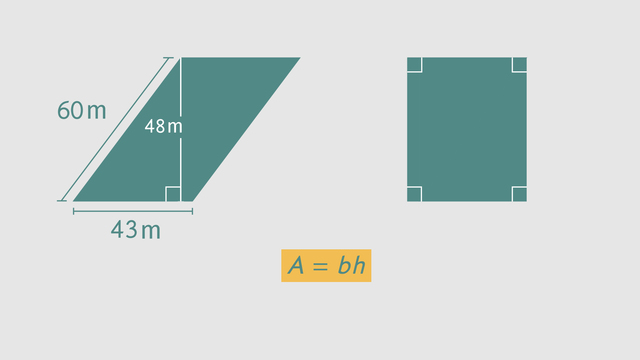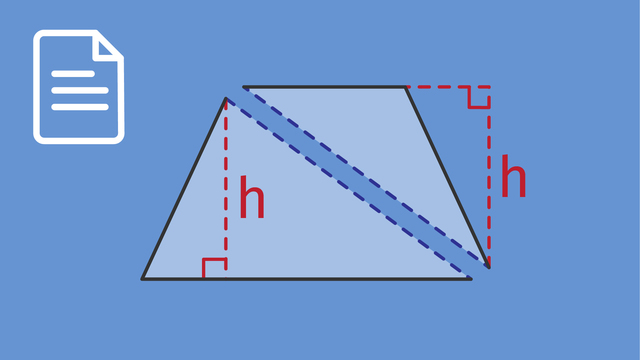Using Rectangles to Find the Area of a Parallelogram


Basics on the topic Using Rectangles to Find the Area of a Parallelogram
After this lesson, you will understand and be able to apply the area formula for a parallelogram.
The lesson begins with a review of the characteristics of parallelograms and quadrilaterals. It then shows how you can decompose a parallelogram into smaller shapes, and then compose them to form a rectangle. This leads to the area formula for a parallelogram.
Learn about the area of parallelograms by helping the mayor launch her Revitalize the City project!
This video includes key concepts, notation, and vocabulary such as: quadrilateral (a 4-sided shape); parallelogram (a quadrilateral that has two sets of parallel sides); composition (creating a new shape by putting together other shapes); and decomposition (breaking a shape apart into smaller shapes).
Before watching this video, you should already be familiar with quadrilaterals, right triangles, parallel lines, perpendicular lines, and how to calculate the area of a rectangle.
After watching this video, you will be prepared to find the area for other geometric shapes using composition and decomposition.
Common Core Standard(s) in focus: 6.G.A.1 A video intended for math students in the 6th grade Recommended for students who are 11-12 years old
Transcript Using Rectangles to Find the Area of a Parallelogram
The mayor of Polygon, Pennsylvania is launching a "Revitalize the City" campaign to engage people in projects that make their city a better place to live. Today, she's meeting with a citizen who has a reputation for his "back to nature" approach to urban planning. He proposes to transform some of the city's empty lots into beautiful public parks by using rectangles to find the area of parallelograms. Before the landscaping project begins, we need to know the area of each vacant lot that will be rejuvinated. This underdeveloped plot of land is shaped like a parallelogram. A parallelogram is a type of quadrilateral. You may recall that the "quad" in quadrilateral means 4, which is how many sides these shapes have. As the name "parallelogram" suggests, both sets of its sides are parallel. What do you remember about parallel lines? Well, for one thing, if you extend them forever they will never intersect. You already know one kind of parellelogram a rectangle. It's a four-sided shape, with two sets of parallel sides. So what makes rectangles special? In a rectangle, all the interior angles are right angles which is indicated by this right angle symbol here. Now that we know a bit more about it, let's take a look at the exact dimensions of our parallelogram. One set of sides measures 50 meters across. The other sides are 40 meters. This line is 30 meters, and it measures the height. We know this is the height, because it's perpendicular with one of the sides. Perpendicular means they meet at a right angle, which again is indicated by this right angle symbol. The side that forms a right angle with our height is called the base. So we want to figure out the area of this shape. You already know how to find the area of rectangles. Let's see if we can find a way to use that knowledge here. Imagine breaking down our parallelogram into smaller, more familiar shapes. What shapes can you imagine creating? This process of breaking apart a shape is called decomposition. Now, we can move the pieces around without changing the area of the parallelogram. Where could we place this piece, so we are left with one large shape whose area we know how to calculate? By moving this right triangle to the other side we can make a rectangle. Notice that it now has four right angles. This process is called composition, which just means putting things together. Now we can easily calculate the new park's area, by multiplying 50 meters times 30 meters. That gives us an area of 1,500 square meters. Notice that the numbers we multiplied to calculate the area were the base and height of our parallelogram. And we didn't even need the other set of sides! Think that will always be true? Let's find out with our next example which is another parallelogam-shaped lot. One set of parallel sides measures 60 meters the other sides are 43 meters and the height is 48 meters. Just like in our last example, we know this line measures the height, because it is perpendicular to the base. So how would you find the area of this parallelogram? In our last example, we calculated the area by multiplying the length of the base times the height. To see if that works again, first decompose the parallelogram into smaller shapes then use those shapes to compose a rectangle. It looks like the formula we found in the last example also applies to this parallelogram. We can use this formula to find the area of any parallelogram: area equals base times the height. Our base is 43 so is our height 48 or 60? Remember, the height of a parallelogram is perpendicular to the base. So our height is 48. Multiplying these numbers together gives us our area of 2,064 square meters. To review: All parallelograms, no matter their size and shape, can be decomposed and then composed into rectangles. You can calculate their area by multiplying the base times the height. The height tells us how tall the shape is, and it's always perpendicular to the base. So keep your eyes open for this symbol, when trying to determine a parallelogram's height. Back in Polygon, Pennsylvania, the mayor has decided to check in on how the park project is going. Yikes. I guess that eccentric citizen went a little bananas?
Using Rectangles to Find the Area of a Parallelogram exercise
-
What is a parallelogram?
HintsParallelograms can also be:
- rhombus
- squares
- rectangles
There are 3 total correct answers.
SolutionTrue Statements about Parallelograms:
- A parallelogram is considered a quadrilateral.
- A parallelogram has opposite sides that are parallel and equal in length.
- A parallelogram has equal opposite angles and it can look like a slanted rectangle.
-
How can we use decomposition and composition to find the area of a parallelogram?
HintsA parallelogram is similar to a rectangle because both shapes have opposite sides that are equal in length and parallel.
Parallelograms and rectangles use the same formula to find the area ($A=bh$).
SolutionA parallelogram is a shape with four sides where the opposite sides are equal in length and parallel to each other. To find the area of a parallelogram, the formula $A=bh$ can be used. We need to identify the base and the height of the shape.
You will notice a parallelogram has the same formula for area as a rectangle. This is possible because a parallelogram can be turned into a rectangle through decomposition. Decomposing a parallelogram means removing a triangle from one side and moving it to the opposite end to make a rectangle.
When the shapes are arranged to form a new shape, this process is called composition. Now the shape is simply a rectangle, and this is why the formula is the same for finding the area. To find the area of this we simply can identify the base and height and multiply!
-
Use rectangles to find the area of a parallelogram.
HintsDecomposing a parallelogram means cutting it and rearranging its pieces to make a rectangle which can help us to calculate the area.
The base of a parallelogram is any one of its sides, and the height is the perpendicular distance from the base to the opposite side.
Remember to use the formula $A=bh$ when calculating the area of a parallelogram.
Solution- base = 6 cm; height = 3 cm
- base = 6 cm; height = 2 cm
- base = 8 cm; height = 2 cm
- base = 8 cm; height = 3 cm
-
Find the area of the parallelogram.
HintsThe formula to find the area of a parallelogram is $A=bh$.
Pay careful attention to which numbers represent the length of the base and height.
$b$ = base
$h$ = height
Solution$b=8\:cm$
$h=4\:cm$
$A=bh$
$A=8 \cdot 4$
Area = 32 cm$^2$
-
Use a rectangle to find the area of the parallelogram.
HintsThe formula to find the area of a parallelogram is $A=bh$.
The base and height are labeled on the parallelogram.
SolutionFirst, decompose to create a rectangle to find the area of this parallelogram.
Next, notice that the $b=10\:cm$ and the $h=5\:cm$.
These two values can be substituted in to the formula,
$A=10 \cdot 5$
-
Solve problems with parallelograms.
HintsFormula for the Area of a Parallelogram: $A=bh$
$b$ = base
$h$ = height
The base of a parallelogram is any one of its sides, and the height is the perpendicular distance from the base to the opposite side.
Think about what two factors would have a product of $55$.
Solution$A=bh$
$b=11$
$h=5$
$A=11 \cdot 5$
$A=55\:in^2$












